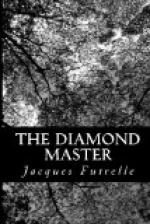THE FIRST DIAMOND
There were thirty or forty personally addressed letters, the daily heritage of the head of a great business establishment; and a plain, yellow-wrapped package about the size of a cigarette-box, some three inches long, two inches wide and one inch deep. It was neatly tied with thin scarlet twine, and innocent of markings except for the superscription in a precise, copperplate hand, and the smudge of the postmark across the ten-cent stamp in the upper right-hand corner. The imprint of the cancellation, faintly decipherable, showed that the package had been mailed at the Madison Square substation at half-past seven o’clock of the previous evening.
Mr. Harry Latham, president and active head of the H. Latham Company, manufacturing jewelers in Fifth Avenue, found the letters and the package on his desk when he entered his private office a few minutes past nine o’clock. The simple fact that the package bore no return address or identifying mark of any sort caused him to pick it up and examine it, after which he shook it inquiringly. Then, with kindling curiosity, he snipped the scarlet thread with a pair of silver scissors, and unfolded the wrappings. Inside was a glazed paper box, such as jewelers use, but still there was no mark, no printing, either on top or bottom.
The cover of the box came off in Mr. Latham’s hand, disclosing a bed of white cotton. He removed the downy upper layer, and there—there, nestling against the snowy background, blazed a single splendid diamond, of six, perhaps seven, carats. Myriad colors played in its blue-white depths, sparkling, flashing, dazzling in the subdued light. Mr. Latham drew one long quick breath, and walked over to the window to examine the stone in the full glare of day.
A minute or more passed, a minute of wonder, admiration, allurement, but at last he ventured to lift the diamond from the box. It was perfect, so far as he could see; perfect in cutting and color and depth, prismatic, radiant, bewilderingly gorgeous. Its value? Even he could not offer an opinion—only the appraisement of his expert would be worth listening to on that point. But one thing he knew instantly—in the million-dollar stock of precious stones stored away in the vaults of the H. Latham Company, there was not one to compare with this.
At length, as he stared at it fascinated, he remembered that he didn’t know its owner, and for the second time he examined the wrappings, the box inside and out, and finally he lifted out the lower layer of cotton, seeking a fugitive card or mark of some sort. Surely the owner of so valuable a stone would not be so careless as to send it this way, through the mail—unregistered—without some method of identification! Another sharp scrutiny of box and cotton and wrappings left him in deep perplexity.




